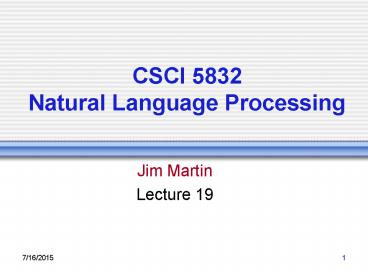CSCI 5832 Natural Language Processing PowerPoint PPT Presentation
Title: CSCI 5832 Natural Language Processing
1
CSCI 5832Natural Language Processing
- Jim Martin
- Lecture 19
2
Today 4/1
- More semantics
- Dealing with quantifiers
- Dealing with ambiguity
3
Example
Even if this is the right tree, what does that
tell us about the meaning?
4
Meaning Representations
- Were going to take the same basic approach to
meaning that we took to syntax and morphology - Were going to create representations of
linguistic inputs that capture the meanings of
those inputs. - But unlike parse trees and the like these
representations arent primarily descriptions of
the structure of the inputs
5
Meaning Representations
- In most cases, theyre simultaneously
descriptions of the meanings of utterances and of
some potential state of affairs in some world.
6
Meaning Representations
- What could this mean
- representations of linguistic inputs that capture
the meanings of those inputs - For us it means
- Representations that permit or facilitate
semantic processing
7
Representational Schemes
- Were going to make use of First Order Logic
(FOL) as our representational framework - Not because we think its perfect
- Many of the alternatives turn out to be either
too limiting or - They turn out to be notational variants
8
FOL
- Allows for
- The analysis of truth conditions
- Allows us to answer yes/no questions
- Supports the use of variables
- Allows us to answer questions through the use of
variable binding - Supports inference
- Allows us to answer questions that go beyond what
we know explicitly
9
Example
- Mary gave a list to John.
- Giving(Mary, John, List)
- More precisely
- Gave conveys a three-argument predicate
- The first arg is the subject
- The second is the recipient, which is conveyed by
the NP in the PP - The third argument is the thing given, conveyed
by the direct object
10
Better
- Turns out this representation isnt quite as
useful as it could be. - Giving(Mary, John, List)
- Better would be
11
Predicates
- The notion of a predicate just got more
complicated - In this example, think of the verb/VP providing a
template like the following - The semantics of the NPs and the PPs in the
sentence plug into the slots provided in the
template
12
Semantic Analysis
- Semantic analysis is the process of taking in
some linguistic input and assigning a meaning
representation to it. - There a lot of different ways to do this that
make more or less (or no) use of syntax - Were going to start with the idea that syntax
does matter - The compositional rule-to-rule approach
13
Compositional Analysis
- Principle of Compositionality
- The meaning of a whole is derived from the
meanings of the parts - What parts?
- The constituents of the syntactic parse of the
input - What could it mean for a part to have a meaning?
14
Example
- AyCaramba serves meat
15
Compositional Analysis
16
Augmented Rules
- Well accomplish this by attaching semantic
formation rules to our syntactic CFG rules - Abstractly
- This should be read as the semantics we attach to
A can be computed from some function applied to
the semantics of As parts.
17
Example
- Attachments
- PropNoun.sem
- MassNoun.sem
- AyCaramba
- MEAT
- Easy parts
- NP -gt PropNoun
- NP -gt MassNoun
- PropNoun -gt AyCaramba
- MassMoun -gt meat
18
Example
- S -gt NP VP
- VP -gt Verb NP
- Verb -gt serves
- VP.sem(NP.sem)
- Verb.sem(NP.sem)
- ???
19
Lambda Forms
- A simple addition to FOL
- Take a FOPC sentence with variables in it that
are to be bound. - Allow those variables to be bound by treating the
lambda form as a function with formal arguments
20
Example
21
Example
22
Example
23
Example
24
Integration
- Two basic approaches
- Integrate semantic analysis into the parser
(assign meaning representations as constituents
are completed) - Pipeline assign meaning representations to
complete trees only after theyre completed
25
Example
- From BERP
- I want to eat someplace near campus
- Two parse trees, two meanings
26
Pros and Cons
- If you integrate semantic analysis into the
parser as its running - You can use semantic constraints to cut off
parses that make no sense - You assign meaning representations to
constituents that dont take part in the correct
(most probable) parse
27
Break
- New schedule is up.
- Finish 18 today.
- Next time WSD (secs 20.1 through 20.5)
- Next week Chapter 22
- Quiz
- Average was 43 (out of 55)
- Ill go over it next time.
- Next quiz
- 4/17
- Covers 17, 18, 20, 21, 22
28
Quantifiers
- Unfortunately, things get a bit more complicated
when we start looking at more complicated NPs. - The previous examples simplified things by only
dealing with constants (FOL Terms). That is
things that can be plugged into FOL predicates.
What about... - A menu
- Every restaurant etc
- Not every waiter
29
Quantifers
- Every restaurant closed.
30
Quantifiers
- Roughly every in an NP like this is used to
stipulate something about every member of the
class. The NP is specifying the class. And the
VP is specifying the thing stipulate.... So the
NP is a template like.
31
Quantifiers
- But thats not combinable with anything so wrap a
lambda around it...
32
Rules
33
Example
34
Every Restaurant Closed
35
Problem
- Every restaurant has a menu.
36
Next Time
- Underspecification

